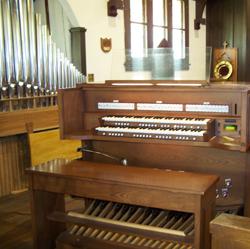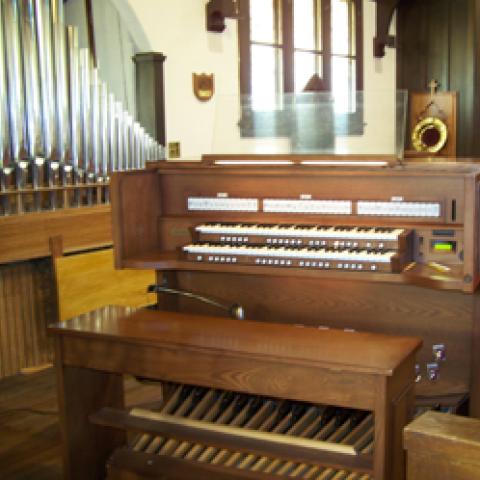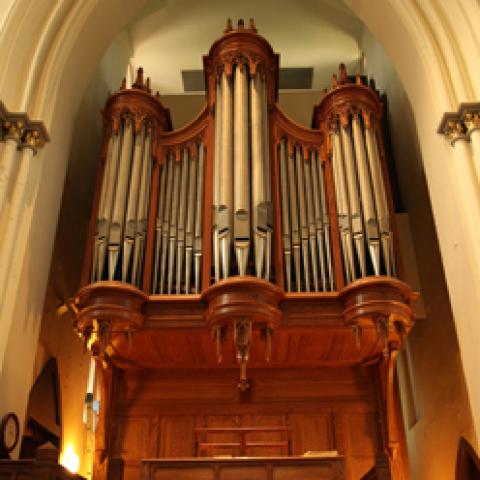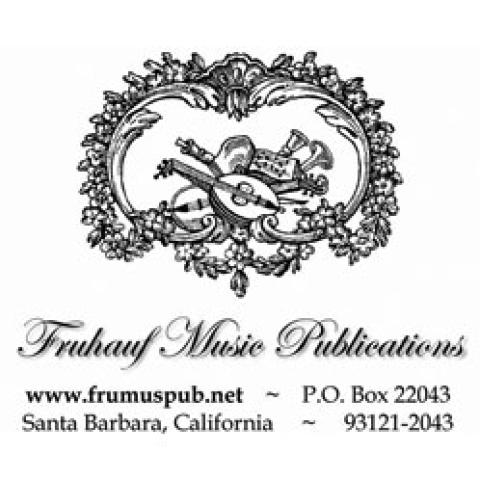News from Iowa State University
1. Spring Carillon and Organ Festival 1997
Iowa State University hosted the Spring Carillon and Organ
Festival 1997 and the Carillon Composition Competition during the weekend of April 25-27. The Festival also celebrated the tenth anniversary of the installation and dedication of the Brombaugh organ of the Music Department. Guest artists were Brian Swager, former University Carillonneur at Indiana University, Bloomington, and David Dahl, organist from Pacific Lutheran University, Tacoma, Washington. The Festival began with two recitals by the guest artists. Brian Swager performed carillon music from Belgium and America that included Johan Franco's Ames Nocturne, a work commissioned by The Stanton Memorial Carillon Foundation in 1984. David Dahl performed organ works by two women composers: Fanny Mendelssohn and Ethel Smyth, and Michel Corrette's Magnificat du 3e et 4e ton with Donald Simonson as cantor. A workshop on "Organ Works by Three 19th-century Women Composers: Clara Schumann, Fanny Mendelssohn and Ethel Smyth" was conducted by David Dahl on Saturday morning, and Brian Swager held a carillon seminar in the afternoon on "Music for the Carillon: A Distinguished Repertoire Emerges." The Festival continued with a Family Concert featuring ISU student carillonneurs, ISU Wind Ensemble, ISU Dance Tour Company, and ISU Oratorio Choir. Echo by Amy Michelle Black was premiered by Michael Tammaro at the carillon and the Oratorio Choir under the baton of Robert Molinson. The Festival concluded on Sunday with carillon music from The Netherlands performed by Tin-shi Tam, Iowa State University Carillonneur.
A Carillon
Composition Competition was held to encourage young composers to write original
carillon music. Judges were Brian Swager, Jeffrey Prater, and
style="mso-spacerun: yes"> Tin-shi Tam. Contestants were from all
parts of the country and overseas. The winning composition was By de dei
lâns (The Proceedings of the Day) by Klaas R. R. de Haan of Amsterdam,
The Netherlands. It was premiered by
Tin-shi Tam during the Festival. The next Spring Carillon Festival
and Carillon Composition
Competition will be held from
April 24-26, 1998. Guest carillonneur will be Albert Gerken, University
Carillonneur at University of
Kansas, Lawrence.
II. Junior High Keyboard Camp
The Fifth Annual Keyboard Explorations junior high school
summer music camp was hosted by the Iowa State University Music Department from
July 7-12, 1997. Participants had the opportunity to learn about various kinds
of keyboard instruments and had hands-on experiences in playing them. Seven
participants studied carillon under ISU Carillonneur, Tin-shi Tam. Two carillon
concerts were performed by students towards the end of the week.
III. 1998 Carillon Composition Competition
Iowa State University has announced the Carillon Composition
Competition '98. The purpose of the competition is to encourage the writing of
original carillon compositions by composers under age 35. The submitted work
shall be an original composition for four-octave carillon (tenor C to C4), with
a two-octave pedal board (tenor C to C2). The composition may be a solo, duet
for one carillon, or a work for carillon with one or more other instruments or
chorus. The submitted composition must be postmarked no later than March 31,
1998. For more information contact the University Carillonneur at Iowa State
University; Music Department; 149 Music Hall; Ames, IA 50011; phone:
515/294-2911, e-mail: tstam@iastate. edu or web-site: www.music.iastate.edu
Bell information requested
In celebration of the 75th anniversary of the Belgian
Carillon School, a festschrift will be published. Marc Van Bets is preparing a
paper on Mechelen bellfounders for this book. He requests reports on all
Mechelen bells that currently are, or ever have been, in
style="mso-spacerun: yes"> North America. Such bells would have
been brought by Capuchin monks who came to North America as missionaries. All
bells are included in the scope of the paper: carillon, church, tolling,
ornamental, etc. All information is welcome, such as the function of the bell,
measurements, pitch, anecdotes, photos. Please contact Marc Van Bets; Ridder
Dessainlaan 27; 2800 Mechelen; Belgium. Phone: (0112)32.15.42.38.52. Fax:
(011)32.15.43.17.07. Email: [email protected]
1998 Queen Fabiola Competition
Since its founding in 1922 the Royal Carillon School
"Jef Denyn" in Mechelen, Belgium, has fostered a greater blossoming
of the carillon art. Toward this end, the school established the Queen Fabiola
International Carillon Competition in 1987. This competition has grown rapidly,
becoming the most important of its kind and providing a strong stimulus for the
recognition of the carillon art as a high-quality artistic expression.
The winners of the first three competitions were: Geert
D'hollander of Belgium in 1987; Boudewijn Zwart of The Netherlands, in 1990;
and Gideon Bodden of The Netherlands, in 1993.
The fourth Queen Fabiola Competition will take place August
5-9, 1998. Carillonneurs from around the world are invited to take part. There
is no age limit. After an elimination round, a maximum of six competitors will
be selected for the finals. Judging will be done by an international jury.
The candidates are required to present nine pieces of a high
virtuosic level: three baroque, three romantic, and three contemporary pieces.
The romantic and contemporary selections must be original carillon compositions
and not transcriptions. One of the baroque pieces must be a carillon prelude
written by Matthias van den Gheyn. In addition, there will be an obligatory
piece.
The school's 1997 international composition competition
brought 21 entries from seven countries: Belgium, The Netherlands, Australia,
The USA, Spain, Russia, and Sweden. Performance of the winning composition will
be required for participants in the Queen Fabiola Competition. Winners of the
composition competition will be announced once registration for the Fabiola
Competition is closed.
During the competition, the participants perform on the new
carillon in the St. Rombouts tower. This instrument was founded by Koninklijke
Eijsbouts in 1981. It is tuned in equal temperament and consists of 49 bells;
the bourdon sounds F and weighs eight tons.
The first-prize winner will receive 100,000 BF, a bronze
bell, a certificate, and a concert tour in Belgium in 1999. Five additional prizes with cash awards will be
given. The SABAM prize of 25,000 BF will be awarded for the best interpretation
of a contemporary Flemish carillon composition, and an additional 25,000 BF
will reward the best improvisation. Participants should send their completed
applications to the Royal Carillon School "Jef Denyn"
style="mso-spacerun: yes"> before April 30, 1998. After their
repertoire has been approved, the full list of regulations and practical
information will be sent to each competitor. The obligatory piece will be sent
to the participants two months before the beginning of the competition.
Participants are granted a per diem of 1000 BF for as long as they take part in
the competition.
For information and applications, contact
style="mso-spacerun: yes"> the Royal Carillon School "Jef
Denyn"; Frederik de Merodestraat 63; 2800 Mechelen; Belgium. Phone:
32.15.20.47.92. Fax: 32.15.20.31.76.
McLellan appointed at MSU
Ray McLellan has been appointed University Carillonneur at Michigan State University in East Lansing, Michigan. His responsibilities include playing weekly recitals, teaching carillon and organ, coordinating and
producing the MSU Summer Carillon Recital Series. Ray studied carillon with
Margo Hal-sted at the University of Michigan and with Todd Fair at the
Netherlands Carillon School. He earned the Bachelor of
style="mso-spacerun: yes"> Arts degree at Florida Southern College
in Lakeland and the Master of Music and Doctor of Musical Arts degrees at the
University of Michigan. He also studied on full scholarship at the
Pädagogische Hochschule in Freiburg, Germany. Besides the position at MSU,
Dr. McLellan continues in his church and temple positions.






